The kitchen has been awash in ferments for the past few months, although they’ve been whittled down to a preferred few. the thing about ferments is that they’re like pets; it’s a commitment to a living thing, that can be slightly neglected, but not too drastically without consequences. So if you’re interested, you have to know what you’re getting into.
Sourdough is a cat while you’re getting it established – temperamental, changing, insistent when it needs to be cared for, but very rewarding once it’s found its groove. Then it’s a fish, happily sleeping in its corner of the fridge, ready to entertain you when you bring it out into the light.
Yogurt, fil mjolk, dairy kefir – these are the dogs of the ferment world – you have to feed and walk them daily. i had a short affair with these but in the end had to bid them farewell. Very good yogurt (even organic) is easy to get in turkey, so it can be easily reproduced if I want to make it at home. As for the others, well, in the end, when you culture things, you then have to eat them, and there just aren’t enough people in this household to handle daily kefir or other dairy drinks (as delicious as fil mjolk is, by the way, I was very sad about that since it doesn’t exist here).
But the ones I’m most attached to, these are the effervescent, flighty birds – kombucha and water kefir. They do need tending to, you have to feed them, and clean their cages of the lees, but they are fairly forgiving (kombucha needs a week to ferment and in cooler temps can go longer; water kefir 48 hours, by which time you’ve finished the last bottle anyway, so there’s an incentive).
The thing is, Coke and Fanta and Sprite have taken over the whole world. Traditional beverages have been displaced everywhere (really, we wonder why diabetes is on the rise?). I had been looking for some time online, trying to find a healthy alternative (still working on a viable non-alcoholic beer recipe). I heard of a ginger plant, and experimented with trying to culture ginger; it wasn’t bad but it wasn’t so good either. Then I found water kefir, thanks to this site, which is full of interesting information and all you ever wanted to know about kefir, and to Gem Cultures, where I was able to order the culture I am now using. They have lots of different stuff by the way, and are very helpful.
Finished water kefir is bubbly, only mildly sweet, with a pleasantly yeasty overtone. It contains only a negligible amount of alcohol (like non-alcoholic beer), provided you don’t culture it in pure fruit juice, and it can be flavored as you like. Best of all, it’s a symbiotic mix of bacterias and yeasts, read, Pro-biotic. So it’s not only delicious, it’s good for you, too. What’s not to like?
The process described below, including a full cycle (straining already cultured kefir and starting a new batch) took me ten minutes from start to finish (plus photos).
There are different ratios on various websites, but I use the following: ¼ c of sugar for 1 liter (quart) of water, and a ¼ c of the kefir grains. If the sugar is not raw/organic (which it isn’t here), it is good to add a ½ tsp or so of molasses, but is not needed every time you culture. Periodically (every 3 or 4 cultures), add a tiny pinch of salt, baking soda and a bit of egg shell (preferably from a hard boiled egg) to provide some minerals, which the grains seem to like. I was quite zealous about this and doing it every time until my grains started to get tired and I read about over-mineralization as well as under-, so…
In a 1-1/2 to 2 quart container with a wide mouth, such as a large jar, dissolve the sugar in the water, add the minerals if using, and then add the grains.
Drop in a dried fig or a few raisins, or another dried fruit. Some folks add a slice of lemon. Cover with a cloth, fixed with a rubber band so no fruit flies come to the party, and leave in a comfortable place for 48 hours.
This is what it looks like after 48 hours or so – the fruit will have swollen and risen to the top. If you are using small fruits such as raisins, pour carefully into the strainer to get as many of them out as possible first so you don’t have to poke through the grains too much (a few will always have to be picked out). Figs or other large fruits can just be plucked out before straining. Great for your compost pile.
Strain the fermented kefir into another container, using a plastic strainer if possible (some people say the grains don’t like metal). Set the strainer with the kefir grains in another dish.
Pour the fermented kefir into an old soda bottle or if you have it, a liter bottle with a grolsch-type top (I use liter bottles from ikea).
Add a small amount of flavoring – fruit juice (about ¼ cup), or a couple of tablespoons of fruit syrup (for example, the red lingonberry syrup from ikea is great), and some chopped fresh ginger, or a vanilla bean. Close the bottle and let ferment for another two days, then refrigerate.
Be careful when opening. The fizz factor is unpredictable. Sometimes we have only a minor pop, but we’ve also decorated the living room wall from about 5 feet away – everyone regretted we didn’t have it on video — and fried the DVR in the process…
This one made a loud pop and there was a lot of gas in the bottle, as is visible from the cloudiness, but no overflow.
2nd round — Prepare your new sugar water and add the kefir grains to start the process again. You can occasionally rinse the kefir grains before returning them to the new water.
Since it’s a living thing, it will grow, but with no regularity. Some people have cultures that double every time they use them, and so they have to give them away or find other uses for them (check dom’s site above for what to do with leftover kefir grains). I started with a tablespoon and they grew very slowly throughout the spring to about ¼ cup, then in early summer grew to nearly a cup. Then with the very high temperatures and humidity, they seemed to get a bit tired, and broke down, so that they were lost through the strainer. I now have about 2/3 cup in total (in two separate jars). When I noticed the decline, I made a stronger solution of sugar water (about ¼ c sugar to 1.5 c water) and put half of the kefir grains into a small jar with this very sweet water into the fridge for a week or two to rest, cycling the batches this way so they stay healthy and I always have a back up.
With a larger amount of grains of course, you can culture a larger amount of sugar water.
It really tastes a lot like champagne, without the punch.
Some people react to this large infusion of probiotics, so it may be best to start with half a cup per day at first. Our household of 3 drinks at least one liter or more per day now.
Kombucha in the next post.

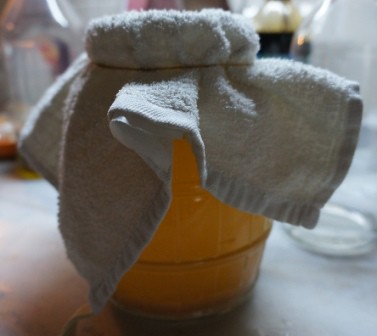
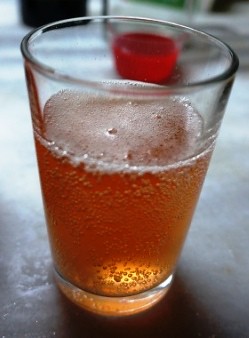


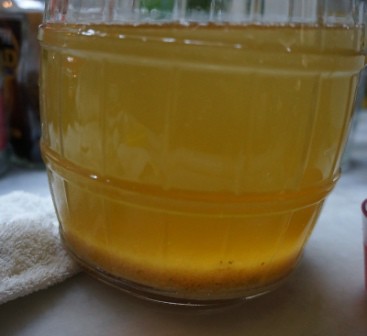
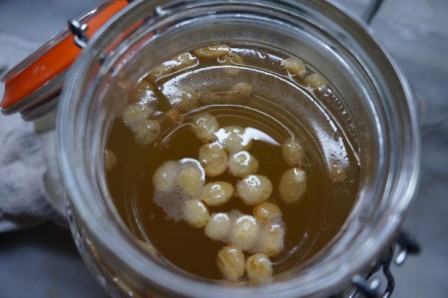


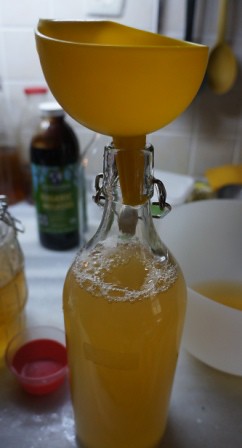

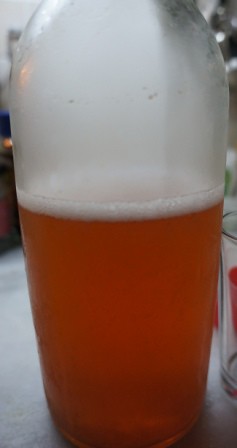
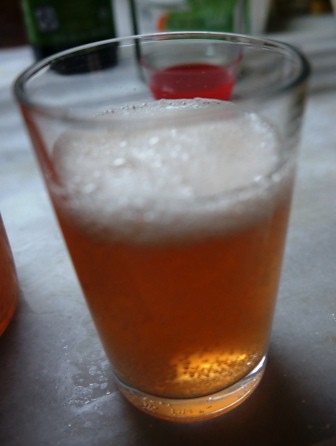
Ah, to be fearless! I admire your effervescent enthusiasm!